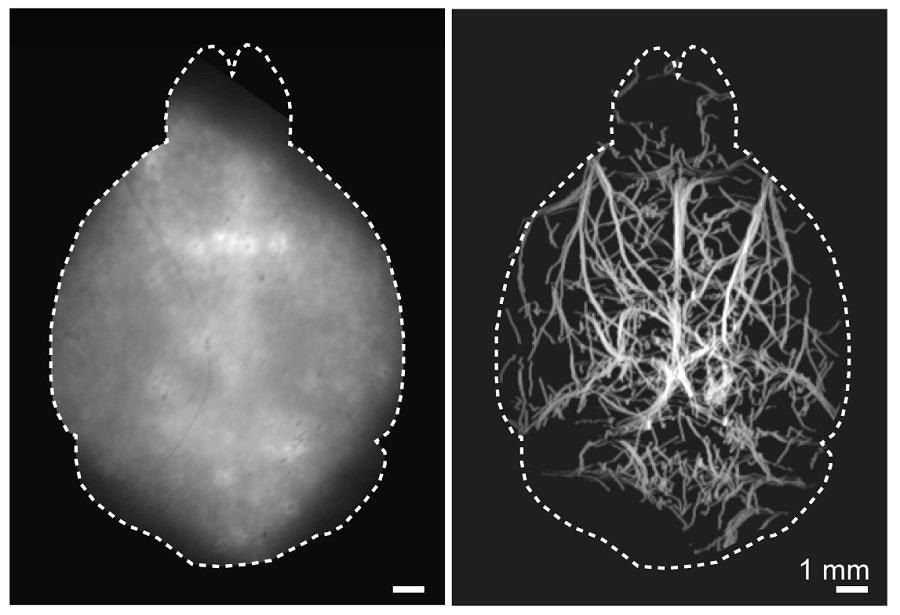May 28 2021
An innovative technique developed by scientists enables microscopic fluorescence imaging at depth limits that are four times greater than those imposed by light diffusion.
 A new imaging method can capture images of vasculature deep in the brains of mice. A conventional widefield fluorescence image of the mouse brain taken non-invasively in the visible light spectrum is shown on the left, while the non-invasive localization-based DOLI approach operating in the NIR-II spectral window is shown on the right. Image Credit: Daniel Razansky, University of Zurich and ETH Zurich.
A new imaging method can capture images of vasculature deep in the brains of mice. A conventional widefield fluorescence image of the mouse brain taken non-invasively in the visible light spectrum is shown on the left, while the non-invasive localization-based DOLI approach operating in the NIR-II spectral window is shown on the right. Image Credit: Daniel Razansky, University of Zurich and ETH Zurich.
Generally, fluorescence microscopy is used for imaging cellular and molecular details of the brain in animal prototypes of a range of diseases but, to date, this technique has been largely restricted to insignificant volumes and highly invasive procedures because of powerful light scattering by the skull and skin.
Visualization of biological dynamics in an unperturbed environment, deep in a living organism, is essential for understanding the complex biology of living organisms and progression of diseases. Our study represents the first time that 3D fluorescence microscopy has been performed fully noninvasively at capillary level resolution in an adult mouse brain, effectively covering a field of view of about 1 centimeter.
Daniel Razansky, Research Team Leader, University of Zurich and ETH Zurich
The University of Zurich and ETH Zurich are both located in Switzerland.
The investigators have explained their new method, known as diffuse optical localization imaging (DOLI), in Optica—The Optical Society’s (OSA) journal meant for high-impact studies. This technique leverages the so-called second near-infrared (NIR-II) spectral window ranging between 1000 and 1700 nm, which has less scattering.
Enabling high-resolution optical observations in deep living tissues represents a long-standing goal in the biomedical imaging field. DOLI’s superb resolution for deep-tissue optical observations can provide functional insights into the brain, making it a promising platform for studying neural activity, microcirculation, neurovascular coupling, and neurodegeneration.
Daniel Razansky, Research Team Leader, University of Zurich and ETH Zurich
Achieving Greater Depth
In the latest method, the investigators intravenously administered fluorescent microdroplets into a live mouse at a level that generates a scant distribution in the bloodstream. Monitoring these flowing targets helps rebuild a high-resolution map of the deep cerebral microvasculature in the animal’s brain.
The method eliminates background light scattering and is performed with the scalp and skull intact. Interestingly, we also observed strong dependence of the spot size recorded by the camera on microdroplet’s depth in the brain, which enabled depth-resolved imaging.
Daniel Razansky, Research Team Leader, University of Zurich and ETH Zurich
This novel technique gains from the latest introduction of short-wave infrared cameras, which are highly efficient and based on InGaAs sensors. Another major building block was the application of new contrast agents that display powerful fluorescence reactions in the NIR-II window, like lead sulfide (PbS)-based quantum dots.
Crisp and Clear Imaging
The investigators initially tested the novel method in synthetic tissue models, called tissue phantoms, that imitate the properties of average brain tissues and demonstrated that microscopic resolution pictures can be obtained at depths of up to 4 mm in optically opaque tissues.
The team subsequently carried out the DOLI technique in live mice in which cerebral microvasculature, as well as the direction and velocity of blood flow, could be fully visualized in a noninvasive manner.
The investigators are exploring ways to improve the accuracy in all three dimensions to enhance the resolution of the DOLI technique. They are also designing better fluorescent agents that have stronger fluorescence intensity, are smaller, and are more stable in vivo. This approach will considerably increase the performance of the DOLI technique with respect to the achievable imaging depth and signal to noise.
“We expect that DOLI will emerge as a powerful approach for fluorescence imaging of living organisms at previously inaccessible depth and resolution regimes. This will greatly enhance the in vivo applicability of fluorescence microscopy and tomography techniques,” concluded Razansky.
Journal Reference:
Zhou, Q., et al. (2021) Diffuse optical localization imaging (DOLI) enables noninvasive deep brain microangiography in NIR-II window. Optica. doi.org/10.1364/OPTICA.420378.